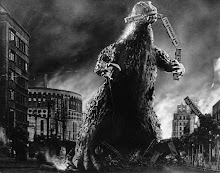
Strike (Stachka) - 1925
Director: Sergei Eisenstein
Writers: Sergei Eisenstein and three other Russian guys with hard to pronounce names
Players: A bunch of Russian nonactors
[http://www.imdb.com/title/tt0015361/]
The Gist:
Mmm, taste that communist propaganda. This was apparently a very appropriate film to follow Manchurian Candidate. Sergei made this film very shortly before Battleship Potempkin, which is one of the most famous silent films of all time. Both films go together very well, have a common visual aesthetic. And in both films you have the sacrificial death of a lowly working class someone or another that spurs the revolt. It's not important who because in these films you have two characters, the working class and the evil capitalist czarist murdering bastards with jowels and fucked up teeth who drop babies from three story buildings and sick the hoses on the working class like it was Alabama in 1963. And those are not exaggerations, they're in the film. Anyway, you throw in a quote from Lenin and beautiful shots of huge masses of workers storming the factory office shouting their demands and you have some powerful nationalistic media.
Why It's Kind of Cool:
It's pretty. It's really pretty. For a film shot in 1925, when America was putting out fairly stellar but visually stagnant productions like Chaplin's Gold Rush and Keaton's The Navigator, Eisenstein turned out to be an artistic madman. The only thing that comes close is some of the German Expressionism stuff like The Cabinet of Dr. Caligari. Eisenstein had beautiful rhythmic editing, great composition, the scenes really burst to life and give the subject matter a great deal of heft.
Why It Could Be Better:
It's 94 minutes long. I know that seems short but not for a silent film, a silent film drama that has a really thin plot (bourgeois ruling class abuses lower working class, working class "strikes" and makes demands for better working conditions, ruling class smoke cigars and balk and set the police on workers, workers are massacred, the end). Also there are loose illuminations of "spies" that weed out some of the strike leaders but these plot elements are poorly developed and often leave the audience trying to piece together what is happening. To reference Dr. Caligari again, that film was 77 minutes long and still could have lost a good ten minutes, but was otherwise perfect for silent film pacing. An even better example is one of my favorite silent films, Sherlock Jr., clocking in at a tight 45 minutes. A perfect length for a silent feature film for the modern audience.

No comments:
Post a Comment